5、Spring Boot缓存
1.JSR107
Java Caching定义了5个核心接口,分别是CachingProvider、CacheManager、Cache、Entry、Expiry。
CachingProvider:定义了创建、配置、获取、管理和控制多个CacheManager。一个应用可以在运行期访问多个CachingProvider。
CacheManager:定义了创建、配置、获取、管理和控制多个唯一命名的Cache,这些Cache存在于CacheManager的上下文中。一个CacheManager仅被一个CachingProvider所拥有。
Cache:是一个类似Map的数据结构并临时存储以Key为索引的值。一个Cache仅被一个CacheManager所拥有。
Entry:是一个存储在Cache中的key-value对。
Expiry:每一个存储在Cache中的条目有一个定义的有效期。一旦超过这个时间,条目为过期的状态。一旦过期,条目将不可访问、更新和删除。缓存有效期可以通过ExpiryPolicy设置。

2.Spring缓存抽象
Spring从3.1开始定义了org.springframework.cache.Cache
和org.springframework.cache.CacheManager接口来统一不同的缓存技术;
并支持使用JCache(JSR-107)注解简化我们开发;
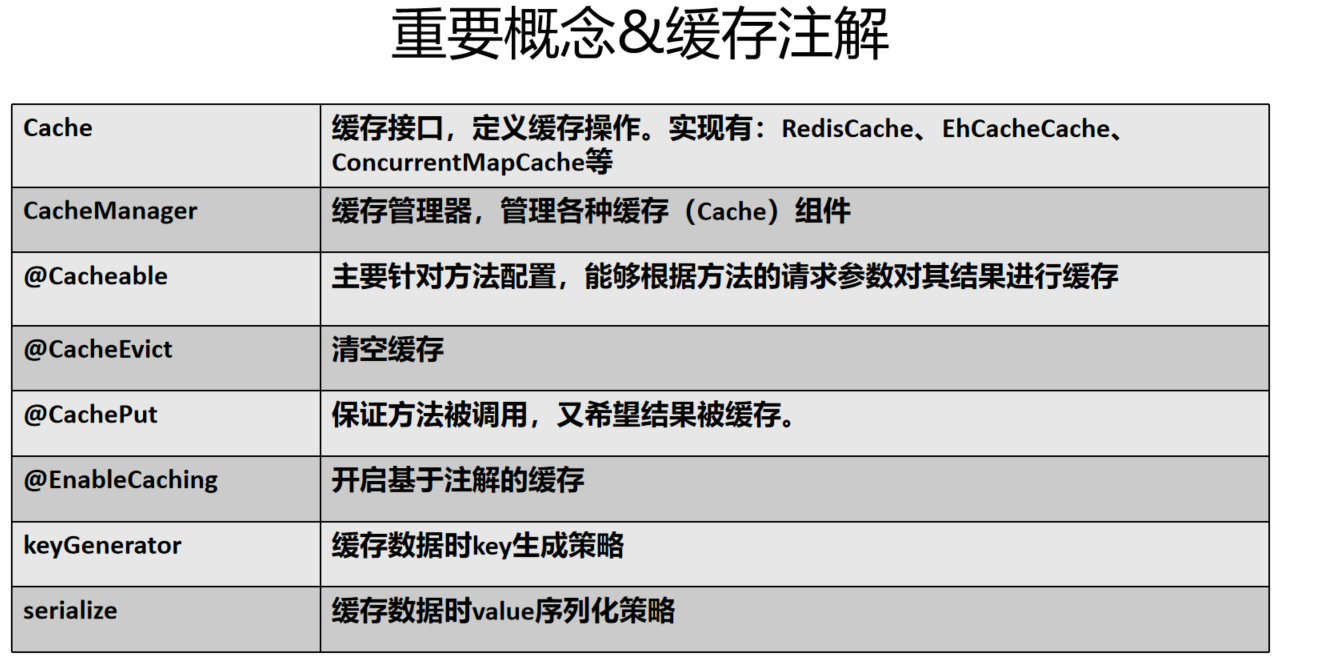
Cache接口为缓存的组件规范定义,包含缓存的各种操作集合;
Cache接口下Spring提供了各种xxxCache的实现;如RedisCache、EhCacheCache、ConcurrentMapCache等;
每次调用需要缓存功能的方法时,Spring会检查检查指定参数的指定的目标方法是否已经被调用过;如果有就直接从缓存中获取方法调用后的结果,如果没有就调用方法并缓存结果后返回给用户。下次调用直接从缓存中获取。
使用Spring缓存抽象时我们需要关注以下两点
确定方法需要被缓存以及他们的缓存策略
从缓存中读取之前缓存存储的数据
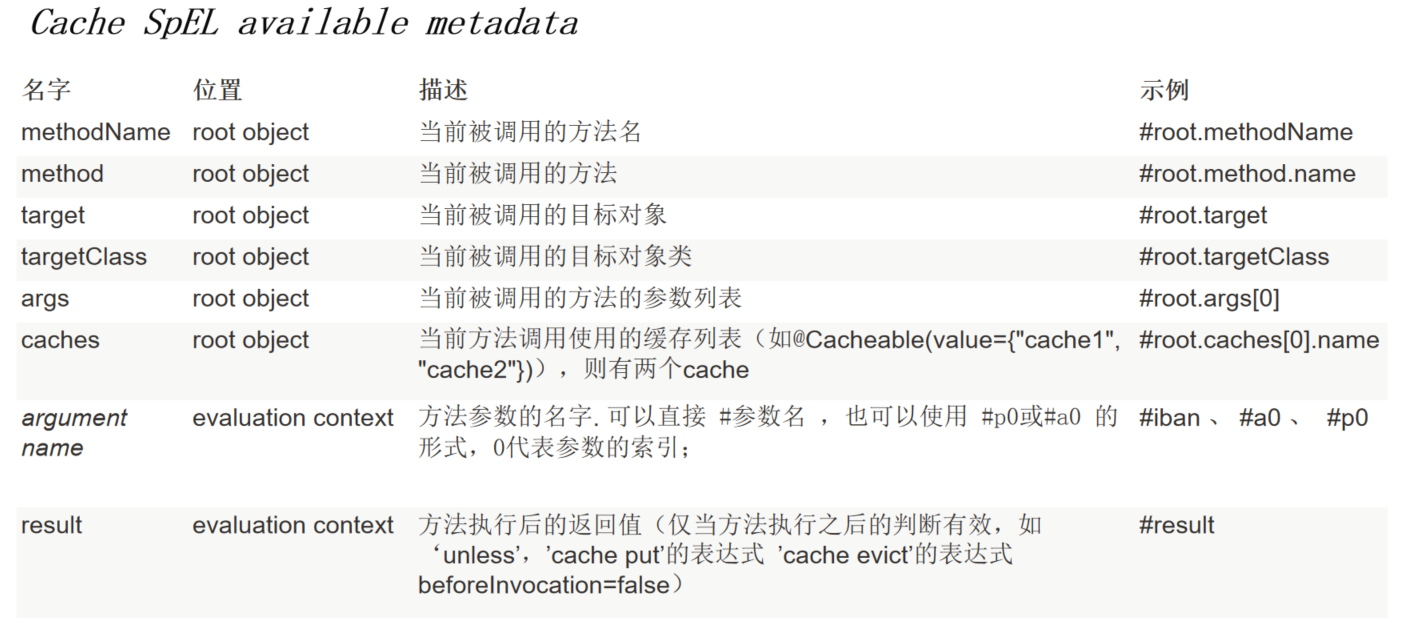
(1).搭建环境
1).导入数据库文件
com.hosystem.cache.bean.Department
|
package com.hosystem.cache.bean; import java.io.Serializable; public class Department implements Serializable { private Integer id; private String departmentName; public Department() { super(); // TODO Auto-generated constructor stub } public Department(Integer id, String departmentName) { super(); this.id = id; this.departmentName = departmentName; } public Integer getId() { return id; } public void setId(Integer id) { this.id = id; } public String getDepartmentName() { return departmentName; } public void setDepartmentName(String departmentName) { this.departmentName = departmentName; } @Override public String toString() { return "Department [id=" + id + ", departmentName=" + departmentName + "]"; } } |
com.hosystem.cache.bean.Employee
|
package com.hosystem.cache.bean; import java.io.Serializable; public class Employee implements Serializable{ private Integer id; private String lastName; private String email; private Integer gender; //性别 1男 0女 private Integer dId; public Employee() { super(); } public Employee(Integer id, String lastName, String email, Integer gender, Integer dId) { super(); this.id = id; this.lastName = lastName; this.email = email; this.gender = gender; this.dId = dId; } public Integer getId() { return id; } public void setId(Integer id) { this.id = id; } public String getLastName() { return lastName; } public void setLastName(String lastName) { this.lastName = lastName; } public String getEmail() { return email; } public void setEmail(String email) { this.email = email; } public Integer getGender() { return gender; } public void setGender(Integer gender) { this.gender = gender; } public Integer getdId() { return dId; } public void setdId(Integer dId) { this.dId = dId; } @Override public String toString() { return "Employee [id=" + id + ", lastName=" + lastName + ", email=" + email + ", gender=" + gender + ", dId=" + dId + "]"; } } |
(2).注解使用
com.hosystem.cache.service.EmployeeService
|
package com.hosystem.cache.service; import com.hosystem.cache.bean.Employee; import com.hosystem.cache.mapper.EmployeeMapper; import org.springframework.beans.factory.annotation.Autowired; import org.springframework.cache.annotation.*; import org.springframework.stereotype.Service; @Service @CacheConfig(cacheNames = "emp") public class EmployeeService { @Autowired EmployeeMapper employeeMapper; /** * 将方法的运行结果进行缓存;下次在调用相同的数据,直接从缓存中获取,不再调用方法; * * CacheManager管理多个cache组件,对缓存的真正CRUD操作在Cache组件中,每一个缓存组件有自己唯一一个名字 * 工作原理: * 1.自动配置类:CacheAutoConfiguration * 2.缓存配置类:GenericCacheConfiguration、JCacheCacheConfiguration、EhCacheCacheConfiguration、HazelcastCacheConfiguration、InfinispanCacheConfiguration、CouchbaseCacheConfiguration、RedisCacheConfiguration、CaffeineCacheConfiguration、SimpleCacheConfiguration、NoOpCacheConfiguration * org.springframework.boot.autoconfigure.cache.GenericCacheConfiguration * org.springframework.boot.autoconfigure.cache.JCacheCacheConfiguration * org.springframework.boot.autoconfigure.cache.EhCacheCacheConfiguration * org.springframework.boot.autoconfigure.cache.HazelcastCacheConfiguration * org.springframework.boot.autoconfigure.cache.InfinispanCacheConfiguration * org.springframework.boot.autoconfigure.cache.CouchbaseCacheConfiguration * org.springframework.boot.autoconfigure.cache.RedisCacheConfiguration * org.springframework.boot.autoconfigure.cache.CaffeineCacheConfiguration * org.springframework.boot.autoconfigure.cache.SimpleCacheConfiguration * org.springframework.boot.autoconfigure.cache.NoOpCacheConfiguration * 3.配置类默认生效:SimpleCacheConfiguration * 4.给容器中注册了一个cacheManager:ConcurrentMapCacheManager * 5.可以获取、创建ConcurrentMapCache类型的缓存组件;它的作用是将数据保存在ConcurrentMap中 * * @Cacheable 运行流程: * 1.方法运行之前,先去查找Cache(缓存组件),按照cacheNames指定的名字获取;(CacheManager先获取相应的缓存)第一次获取缓存如果没有该缓存则会自动创建 * 2.去Cache中查找缓存的内容,使用一个key,默认为方法的参数; * (1).key是按照某种策略生成的;默认是使用keyGenerator生成的,默认使用SimpleKeyGenerator生成key * (2).默认使用SimpleKeyGenerator生成key默认策略:若无参数,key = new SimpleKey();|如果有单个参数,key=参数值;|如果有多个参数,key = new SimpleKey(params); * 3.若为查找到缓存就调用方法 * 4.将方法返回的结果,放入缓存中 * @Cacheable 标注的方法执行之前先来检查缓存中有没有这个数据,默认按照参数的值作为key查找缓存,如果缓存不存在,则运行方法并将结果放入缓存 * 核心: * 1.使用CacheManager[ConcurrentMapCacheManager]按照名字获取cache[ConcurrentHashMapCache]组件 * 2.key使用keyGenerator生成,默认是SimpleKeyGenerator * * 属性:value、cacheNames、key、keyGenerator、cacheManager、cacheResolver、condition、unless、sync * value/cacheNames:指定缓存组件的名字 * key:缓存数据使用的key,可以用它指定参数。默认是使用方法参数的值 * SpEL: #id:参数id的值 #a0 #p0 #root.args[0] * keyGenerator:key生成器;可以指定key生成器组件id; * 注:keyGenerator和key只能二选一 * cacheManager:指定缓存管理器 * cacheResolver:指定获取解析器 * condition:指定符合条件情况下缓存 * unless:否定缓存;当unless指定条件为true时,方法返回值不会被缓存;可以获取结果进行判断 * sync:是否使用异步模式 */ //cacheNames = "emp": //condition = "#id>0":只有当id>0的时候再进行缓存 //condition = "#a0>1":只有当第一个参数>1时候才进行缓存 //unless = "#result==null":当返回结果为空时不进行缓存 //unless = "#a0==2":如果第一个参数的结果为2,则结果不缓存 //key = "#root.methodName+'['+#id+']'" //keyGenerator = "myKeyGenerator":自定义key @Cacheable(cacheNames = "emp"/*,condition = "#a0>1",unless = "#a0==2"*/) public Employee getEmp(Integer id){ System.out.println("查询"+id+"号员工"); Employee emp = employeeMapper.getEmpById(id); return emp; } /** * @CachePut:调用方法同时更新缓存数据 * 修改数据库某个数据 同时更新缓存 * * 运行时间: * 1.先调用方法 * 2.将方法的结果缓存起来 * * 测试步骤: * 1.查询1号员工;查询到的结果会放在缓存中 key:1 value:lastName:张三 * 2.查询结果照旧 * 3.更新1号员工信息[emp?id=1&lastName=zhangs&gender=0];将方法的返回值也放进缓存中 key:传入的employee对象 值:返回的employee对象 * 4.查询1号员工;查询结果为未更新前的数据[1号员工的信息没有在缓存中更新] * key = "#employee.id":使用传入参数的员工id进行更新 * key = "#result.id":使用返回后的id * 注:@Cacheable的key是不能够使用#result */ @CachePut(value = "emp",key = "#result.id") public Employee updateEmp(Employee employee){ System.out.println("update" + employee); employeeMapper.updateEmp(employee); return employee; } /** * @CacheEvict:缓存清除 */ //key = "#id":指定key删除缓存 //allEntries = true:删除缓存中所有数据 默认参数为false //beforeInvocation=false:缓存的清除是否在方法之前执行 默认是false,即清除缓存操作在方法执行之后执行 如果方法出现异常缓存就不会清除 //beforeInvocation = true:清除缓存操作在方法执行之前执行 如果方法出现异常缓存也会清除 @CacheEvict(value = "emp"/*,key = "#id"*//*,allEntries = true*/,beforeInvocation = true) public void deleteEmp(Integer id){ System.out.println("delete"+id); // employeeMapper.deleteEmpById(id); int i = 10/0; } @Caching( cacheable = { @Cacheable(value="emp",key="#lastName") }, put = { @CachePut(value = "emp",key = "#result.id"), @CachePut(value = "emp",key = "#result.email") } ) public Employee getEmpByLastName(String lastName){ return employeeMapper.getEmpByLastName(lastName); } } |
com.hosystem.cache.service.DeptService
|
package com.hosystem.cache.service; import com.hosystem.cache.bean.Department; import com.hosystem.cache.mapper.DepartmentMapper; import org.springframework.beans.factory.annotation.Autowired; import org.springframework.cache.annotation.Cacheable; import org.springframework.stereotype.Service; @Service public class DeptService { @Autowired DepartmentMapper departmentMapper; /** * 缓存的数据能存入redis * 第二次从缓存中查询就不能恢复反序列化 * 存的是dept的json;cachemanager默认使用RedisTemplate<Object, Employee>操作Redis * * @param id * @return */ @Cacheable(cacheNames = "dept") public Department getDeptById(Integer id){ System.out.println("查询部门"+id); Department mapper = departmentMapper.getDeptById(id); return mapper; } } |

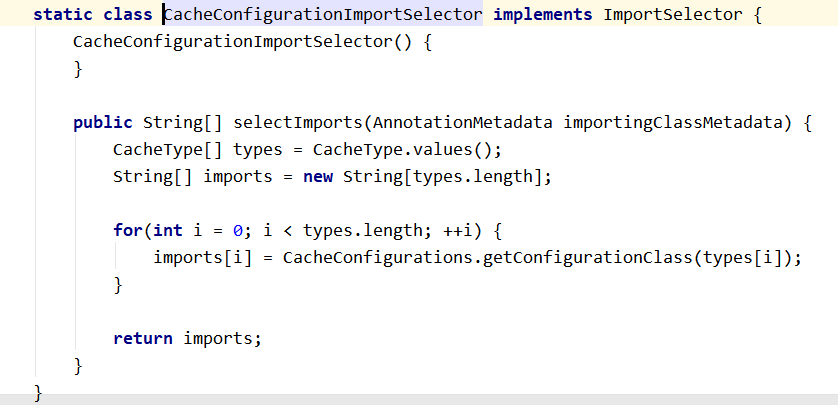
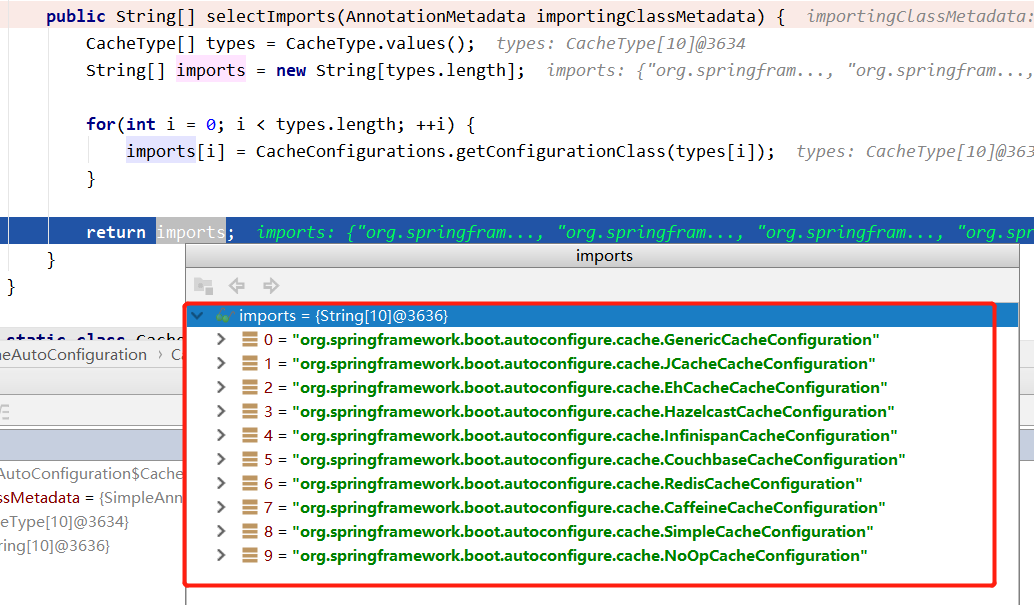

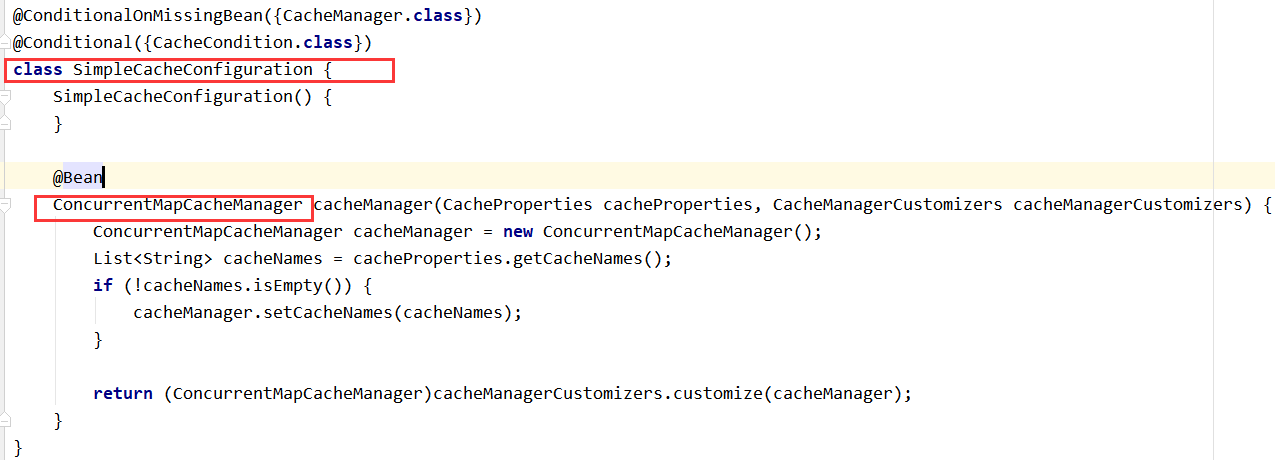
com.hosystem.cache.controller.EmployeeController
|
package com.hosystem.cache.controller; import com.hosystem.cache.bean.Employee; import com.hosystem.cache.service.EmployeeService; import org.springframework.beans.factory.annotation.Autowired; import org.springframework.web.bind.annotation.GetMapping; import org.springframework.web.bind.annotation.PathVariable; import org.springframework.web.bind.annotation.RestController; @RestController public class EmployeeController { @Autowired EmployeeService employeeService; @GetMapping("/emp/{id}") public Employee getEmployee(@PathVariable("id") Integer id){ Employee employee = employeeService.getEmp(id); return employee; } @GetMapping("/emp") public Employee update(Employee employee){ Employee emp = employeeService.updateEmp(employee); return emp; } @GetMapping("/delemp") public String deleteEmp(Integer id){ employeeService.deleteEmp(id); return "success"; } @GetMapping("/emp/lastname/{lastName}") public Employee getEmpByLastName(@PathVariable("lastName") String lastName){ return employeeService.getEmpByLastName(lastName); } } |
com.hosystem.cache.Springboot01CacheApplication
|
package com.hosystem.cache; import org.mybatis.spring.annotation.MapperScan; import org.springframework.boot.SpringApplication; import org.springframework.boot.autoconfigure.SpringBootApplication; import org.springframework.cache.annotation.EnableCaching; /** * 搭建环境 * 1. 导入数据库文件 创建department和employee表 * 2. 创建javaBean封装数据 * 3. 整合mybatis操作数据库 * 1).配置数据源 * 2).使用注解版mybatis * (1).@MapperScan指定需要扫描的mapper接口所在的包 * * 使用缓存 * 1. 开启注解缓存 @EnableCaching * 2. 标注缓存注解 * @Cacheable:针对方法配置,能够根据方法的请求参数对其结果进行缓存 * @CacheEvict:清空缓存 * @CachePut:保证方法被调用,又希望结果被缓存 * * 默认使用的ConcurrentMapCacheManager--->ConcurrentMapCache 将数据保存在ConcurrentMap<Object,Object>中 * 开发中常使用其它缓存中间件:Redis、memcahced * * 整合Redis作为缓存 * Redis 是一个开源(BSD许可)的,内存中的数据结构存储系统,它可以用作数据库、缓存和消息中间件。 * 1.安装docker:https://www.cnblogs.com/HOsystem/p/13789551.html * 2.安装Redis(通过docker):https://www.cnblogs.com/HOsystem/p/13850049.html * 3.配置Redis * 4.测试缓存 * 原理:CacheManager===Cache 缓存组件来实际给缓存中存储数据 * (1).引入redis的starter,容器中保存的是org.springframework.data.redis.cache.RedisCacheManager * (2).org.springframework.data.redis.cache.RedisCacheManager帮忙创建org.springframework.data.redis.cache.RedisCache作为缓存组件; * org.springframework.data.redis.cache.RedisCache通过操作redis缓存数据的 * (3).默认保存数据k-v都是object 利用序列化保存;如何保存为json; * 1).引入了redis的starter,cachemanager变为RedisCacheManage * 2).默认创建RedisCacheManage操作redis的时候使用的是RedisTemplate<Object,Object> * 3).RedisTemplate<Object,Object>默认使用jdk的序列化机制 * (4).自定义CacheManager * */ @MapperScan("com.hosystem.cache.mapper") @EnableCaching @SpringBootApplication public class Springboot01CacheApplication { public static void main(String[] args) { SpringApplication.run(Springboot01CacheApplication.class, args); } } |
(3).docker
1).安装docker
|
https://www.cnblogs.com/HOsystem/p/13789551.html |
2).安装redis
|
https://www.cnblogs.com/HOsystem/p/13850049.html |
3).测试Redis
com.hosystem.cache.Springboot01CacheApplicationTests
|
package com.hosystem.cache; import com.hosystem.cache.bean.Employee; import com.hosystem.cache.mapper.EmployeeMapper; import com.sun.xml.internal.ws.api.ha.StickyFeature; import org.junit.jupiter.api.Test; import org.springframework.beans.factory.annotation.Autowired; import org.springframework.boot.test.context.SpringBootTest; import org.springframework.data.redis.core.RedisTemplate; import org.springframework.data.redis.core.StringRedisTemplate; import org.springframework.data.redis.serializer.RedisSerializer; import org.springframework.lang.Nullable; @SpringBootTest class Springboot01CacheApplicationTests { @Autowired EmployeeMapper employeeMapper; @Autowired StringRedisTemplate stringRedisTemplate; //操作k-v是字符串形式 @Autowired RedisTemplate redisTemplate; //k-v都是对象 @Autowired RedisTemplate<Object,Employee> empRedisTemplate; /** * Redis常见五大数据类型 * String(字符串)、List(列表)、Hash(散列)、Set(集合)、ZSet(有序集合) * stringRedisTemplate.opsForValue():String(字符串) * stringRedisTemplate.opsForList():List(列表) * stringRedisTemplate.opsForHash():Hash(散列) * stringRedisTemplate.opsForSet():Set(集合) * stringRedisTemplate.opsForZSet():ZSet(有序集合) */ @Test public void test01(){ //redis保存数据 // stringRedisTemplate.opsForValue().append("msg","hello"); String msg = stringRedisTemplate.opsForValue().get("msg"); System.out.println(msg); // stringRedisTemplate.opsForList().leftPush("mylist","1"); // stringRedisTemplate.opsForList().leftPush("mylist","2"); } //测试保存对象 @Test public void test02(){ Employee empById = employeeMapper.getEmpById(1); //默认保存对象,使用jdk序列化机制,序列化后的数据保存到redis中 // redisTemplate.opsForValue().set("emp-01",empById); //1.将数据以json的方式保存 //(1).将对象转为json //(2).redisTemplate默认序列化规则;自定义默认序列化规则 // private RedisSerializer keySerializer = null; // private RedisSerializer valueSerializer = null; // private RedisSerializer hashKeySerializer = null; // private RedisSerializer hashValueSerializer = null; // private RedisSerializer<String> stringSerializer = RedisSerializer.string(); empRedisTemplate.opsForValue().set("emp-01",empById); } @Test public void contextLoads() { Employee empById = employeeMapper.getEmpById(1); System.out.println(empById); } } |
docker启动redis失败
|
Error response from daemon: Cannot start container 53fe1fcb2e05214c6f853ef2fe9f65539e69fdc7d6a454bfb073c10c2fba82dd: iptables failed: iptables -t nat -A DOCKER -p tcp -d 0/0 --dport 6379 -j DNAT --to-destination 172.17.0.3:6379 ! -i docker0: iptables: No chain/target/match by that name. |
我们首先对iptables进行防火墙规则配置 允许6379端口可以访问
docker启动redis失败
|
[root@pluto sysconfig]# docker run -d -p 6379:6379 --name myredis redis Error response from daemon: Conflict. The name "myredis" is already in use by container 53fe1fcb2e05. You have to delete (or rename) that container to be able to reuse that name. |
|
[root@pluto sysconfig]# docker ps -a CONTAINER ID IMAGE COMMAND CREATED STATUS PORTS NAMES 53fe1fcb2e05 redis "docker-entrypoint.s 2 minutes ago myredis [root@pluto sysconfig]# docker rm 53fe1fcb2e05 |
(4).自定义CacheManager
|
* 整合Redis作为缓存 * Redis 是一个开源(BSD许可)的,内存中的数据结构存储系统,它可以用作数据库、缓存和消息中间件。 * 1.安装docker:https://www.cnblogs.com/HOsystem/p/13789551.html * 2.安装Redis(通过docker):https://www.cnblogs.com/HOsystem/p/13850049.html * 3.配置Redis * 4.测试缓存 * 原理:CacheManager===Cache 缓存组件来实际给缓存中存储数据 * (1).引入redis的starter,容器中保存的是org.springframework.data.redis.cache.RedisCacheManager * (2).org.springframework.data.redis.cache.RedisCacheManager帮忙创建org.springframework.data.redis.cache.RedisCache作为缓存组件; * org.springframework.data.redis.cache.RedisCache通过操作redis缓存数据的 * (3).默认保存数据k-v都是object 利用序列化保存;如何保存为json; * 1).引入了redis的starter,cachemanager变为RedisCacheManage * 2).默认创建RedisCacheManage操作redis的时候使用的是RedisTemplate<Object,Object> * 3).RedisTemplate<Object,Object>默认使用jdk的序列化机制 * (4).自定义CacheManager |
@Autowired
StringRedisTemplate stringRedisTemplate;

@Autowired
RedisTemplate redisTemplate;

pom.xml
|
<?xml version="1.0" encoding="UTF-8"?> <project xmlns="http://maven.apache.org/POM/4.0.0" xmlns:xsi="http://www.w3.org/2001/XMLSchema-instance" xsi:schemaLocation="http://maven.apache.org/POM/4.0.0 https://maven.apache.org/xsd/maven-4.0.0.xsd"> <modelVersion>4.0.0</modelVersion> <parent> <groupId>org.springframework.boot</groupId> <artifactId>spring-boot-starter-parent</artifactId> <version>2.3.4.RELEASE</version> <relativePath <!-- lookup parent from repository --> |
5、Spring Boot缓存的更多相关文章
- Spring boot缓存初体验
spring boot缓存初体验 1.项目搭建 使用MySQL作为数据库,spring boot集成mybatis来操作数据库,所以在使用springboot的cache组件时,需要先搭建一个简单的s ...
- Spring Boot缓存Ehcache
Spring Boot 整合 Ehcache 修改 pom 文件 <!-- Spring Boot 缓存支持启动器 --> <dependency> <groupId ...
- 3步轻松搞定Spring Boot缓存
作者:谭朝红 前言 本次内容主要介绍基于Ehcache 3.0来快速实现Spring Boot应用程序的数据缓存功能.在Spring Boot应用程序中,我们可以通过Spring Caching来快速 ...
- Spring Boot缓存应用实践
缓存是最直接有效提升系统性能的手段之一.个人认为用好用对缓存是优秀程序员的必备基本素质. 本文结合实际开发经验,从简单概念原理和代码入手,一步一步搭建一个简单的二级缓存系统. 一.通用缓存接口 1.缓 ...
- Spring Boot缓存源码分析
前言 项目里面要增加一个应用缓存,原本想着要怎么怎么来整合ehcache和springboot,做好准备配置这个配置那个,结果只需要做三件事: pom依赖 写好一个ehcache的配置文件 在boot ...
- Spring Boot 缓存的基本用法
目录 一.目的 二.JSR-107 缓存规范 三.Spring 缓存抽象 四.Demo 1.使用 IDEA 创建 Spring Boot 项目 2.创建相应的数据表 3.创建 Java Bean 封装 ...
- Spring Boot 缓存应用 Ehcache 入门教程
Ehcache 小巧轻便.具备持久化机制,不用担心JVM和服务器重启的数据丢失.经典案例就是著名的Hibernate的默认缓存策略就是用Ehcache,Liferay的缓存也是依赖Ehcache. 本 ...
- Spring Boot 缓存应用 Memcached 入门教程
本章学习 Mmecached 在 Spring Boot 中的使用教程.Memcached 与 Redis 各有好处.本文主要学习 Spring Boot 中如何应用集成 Mmecached spri ...
- Spring Boot缓存注解@Cacheable、@CacheEvict、@CachePut使用
从3.1开始,Spring引入了对Cache的支持.其使用方法和原理都类似于Spring对事务管理的支持.Spring Cache是作用在方法上的,其核心思想是这样的:当我们在调用一个缓存方法时会把该 ...
随机推荐
- python 爬虫 循环分页
import osfrom time import sleepimport fakerimport requestsfrom lxml import etreefake = faker.Faker() ...
- css中伪元素before或after中content的特殊用法attr【转】
[原文]https://segmentfault.com/a/1190000002750033 CSS中主要的伪元素有四个:before/after/first-letter/first-line,在 ...
- T-sql语句,group by 加 order by的使用方法
select AuHousesID,sum(Turnover) from Auction group by AuHousesID order by sum(Turnover) desc
- 微信小程序项目wx-store代码详解
这篇文章会很长,非常长,特别长,无敌长. 真的是挤牙膏般的项目进度,差不多是8月底有开始这个项目的想法,时至今日都1个多月了,抛去频繁的加班时间,王者时间,羽毛球时间...见缝插针的写这个项目,我竟然 ...
- 记2020年初对SimpleGUI源码的阅读成果
2020春节,阅读了下SimpleGUI源码,我一直喜欢边阅读,边手绘图片,所以这里只贴几张图片. 一,什么是SimpleGUI ? https://gitee.com/Polarix/simpleg ...
- git学习(九) idea git stash操作
在前面说过,git stash 命令的作用就是将目前还不想提交的但是已经修改的内容进行保存至堆栈中,后续可以在某个分支上恢复出堆栈中的内容:git stash 作用的范围包括工作区和暂存区中的内容,没 ...
- Django( 学习第五部 Django之模板语法)
目录 模板语法 --- 传值 摸板语法 --- 过滤器 模板语法 --- 标签 自定义过滤器.标签.inclusion_tag 模板的继承 模板语法 --- 传值 {{}} 变量相关 {% ...
- pyqt5安装后 pyqt-tools却无法安装解决方法!
逛了逛国外论坛 这哥们跟我一样 我一晚上没睡 就为了这个 原来 我的py版本太高级了 我把py3.9卸载了 换上了老旧的3.76版本 成功了
- js中!!的运用
最近在看vue源码. 里面使用Object.defineProperty()中!!吸引眼球 1 export function def (obj: Object, key: string, val: ...
- 关于HDFS应知应会的N个问题 | 技术点
1. Namenode的安全模式 ? 安全模式是Namenode的一种状态(Namenode主要有active/standby/safemode三种模式). 2. 哪些情况下,Namenode会进入安 ...

